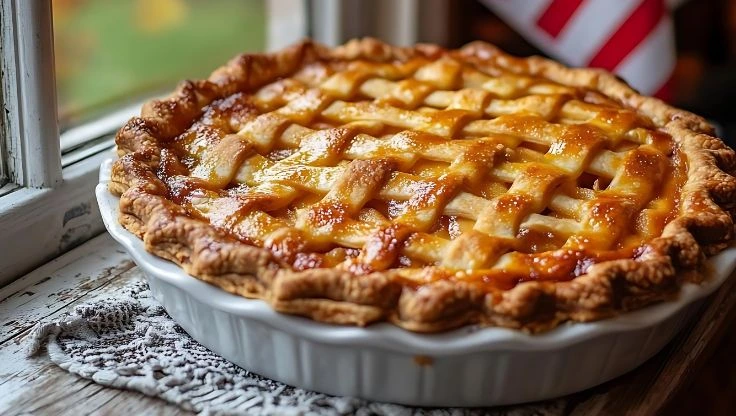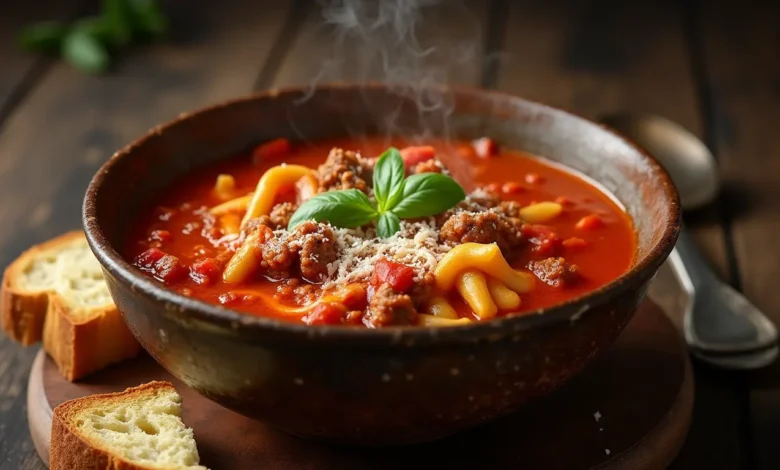
How to Make Lasagna Soup in 20 Minutes: 6 Easy Quick Steps
Table of Contents
The History of Lasagna Soup
Craving the rich flavors of traditional lasagna but short on time? Lasagna soup is the perfect solution. This innovative dish transforms the classic Italian comfort food into a warm, satisfying bowl of soup that captures all the beloved flavors of traditional lasagna. As a professional chef who has specialized in Italian cuisine for over a decade, I’ve seen this creative twist on lasagna gain tremendous popularity in recent years.
The concept of lasagna soup emerged from the Italian-American culinary tradition, where home cooks sought ways to simplify traditional recipes while maintaining authentic flavors. While traditional lasagna dates back to ancient Rome, this modern interpretation began appearing in cookbooks and food blogs in the early 2000s. The genius of this adaptation lies in its ability to deliver the complex flavors of traditional lasagna in a fraction of the time.
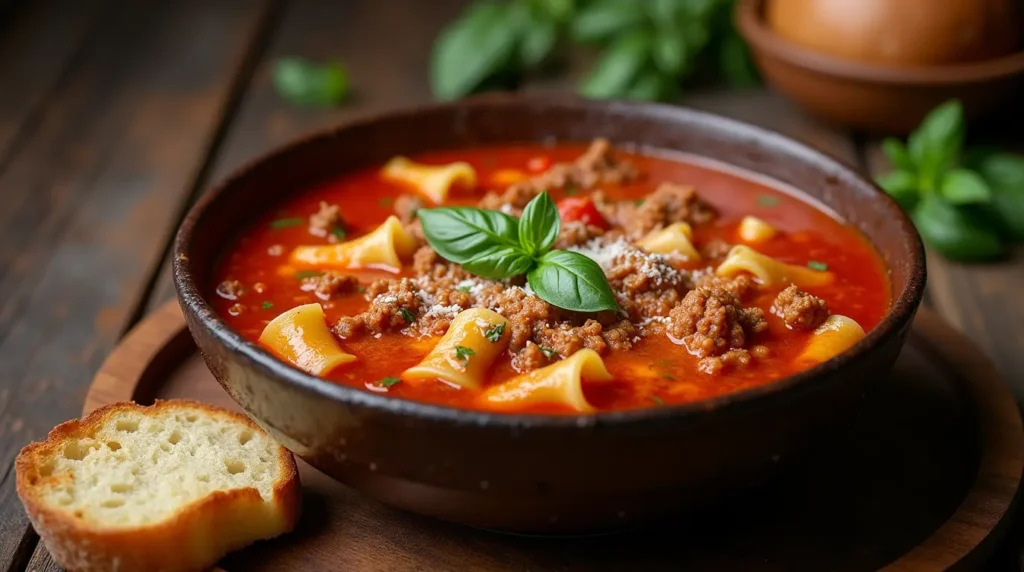
Understanding the evolution of this dish helps appreciate its brilliance. Traditional lasagna requires careful layering, long baking times, and multiple steps. Lasagna soup deconstructs these elements while preserving the essential flavor profile that makes lasagna one of the world’s most beloved comfort foods.
Why This Lasagna Soup Recipe Works
The beauty of this lasagna soup recipe lies in its perfect balance of authenticity and convenience. Here’s what makes this recipe exceptional:
Time and Effort Benefits
- Reduces cooking time from hours to under 30 minutes
- Eliminates the need for careful layering
- Uses one pot instead of multiple dishes
- Simplified cleanup process
- Perfect for batch cooking and meal prep
Flavor and Texture Advantages
- Maintains all the traditional lasagna flavors
- Creates a rich, flavorful broth
- Allows for better melding of ingredients
- Provides a more balanced bite with every spoonful
- Offers easier portion control
Practical Benefits
- More cost-effective than traditional lasagna
- Easily scalable for different serving sizes
- Perfect for both casual and formal occasions
- Excellent leftover potential
- Freezer-friendly
Choosing the Right Ingredients
The Base Components
Selecting quality ingredients is crucial for creating the best lasagna soup. Let’s dive deep into each component:
Ground Meat Selection
The foundation of great lasagna soup starts with the right meat combination:
Ground Beef
- Optimal fat content: 80/20 lean-to-fat ratio
- Provides rich flavor and proper texture
- Look for freshly ground beef when possible
- Grass-fed beef offers enhanced flavor and nutrition
Italian Sausage
- Use a mix of sweet and hot for balanced flavor
- Remove from casings for better texture
- Fresh sausage preferred over pre-cooked
- Adds authentic Italian seasonings and depth
Ground Pork (Optional)
- Enhances richness and moisture
- Complements beef and sausage flavors
- Adds tenderness to the overall dish
Pasta Selection
Choosing the right pasta is crucial for authentic texture:
Traditional Lasagna Noodles
- Regular or oven-ready both work well
- Break into 2-inch pieces for easy eating
- Look for bronze-die cut for better sauce adherence
- Italian-made noodles often have superior texture
Alternative Pasta Options
- Mafalda (mini lasagna noodles)
- Campanelle for interesting texture
- Radiatori for sauce-holding capacity
- Fusilli for casual presentations
Ingredients Table & Prep
Main Ingredients
| Ingredient | Amount | Notes |
|---|---|---|
| Ground beef | 1 pound | 80/20 lean-to-fat ratio |
| Italian sausage | ½ pound | Removed from casing |
| Onion | 1 large | Finely diced |
| Garlic | 4-6 cloves | Minced |
| Crushed tomatoes | 28 oz can | San Marzano preferred |
| Tomato paste | 2 tablespoons | Adds depth |
| Chicken broth | 6-8 cups | Low-sodium |
| Lasagna noodles | 8 ounces | Broken into pieces |
| Ricotta cheese | 1 cup | For serving |
| Mozzarella | 1 cup | Shredded |
| Parmesan | ½ cup | Freshly grated |
| Italian seasoning | 1 tablespoon | |
| Fresh basil | ¼ cup | Chopped |
| Fresh oregano | 2 tablespoons | Chopped |
| Salt and pepper | To taste | |
| Red pepper flakes | ¼ teaspoon | Optional |
Extended Ingredients List for Enhanced Flavor
| Ingredient | Amount | Purpose |
|---|---|---|
| Bay leaves | 2 whole | Depth of flavor |
| Carrots | 2 medium | Sweetness and body |
| Celery | 2 stalks | Traditional soffritto |
| White wine | ½ cup | Deglazing |
| Heavy cream | ¼ cup | Optional richness |
| Spinach | 2 cups | Added nutrition |
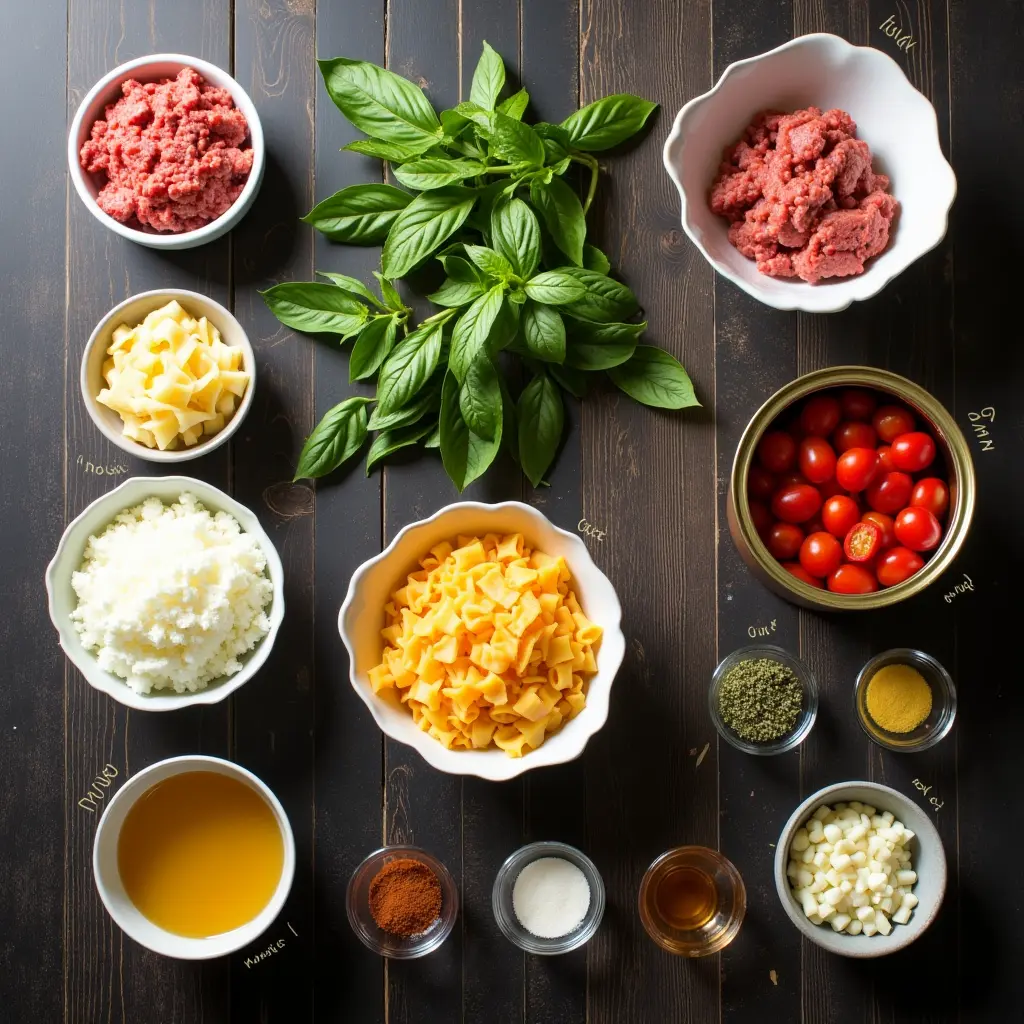
Prep Essentials
Proper preparation is key to a smooth cooking process:
Advance Prep
- Break lasagna noodles into uniform pieces
- Dice all vegetables consistently
- Bring cheese to room temperature
- Measure all ingredients before starting
- Prepare herb garnishes
Equipment Needed
- Large Dutch oven (6-8 quart)
- Sharp knife for prep
- Wooden spoons for stirring
- Measuring cups and spoons
- Cheese grater
- Ladle for serving
- Storage containers
Step-by-Step Cooking Instructions
Pre-Cooking Prep (15 minutes)
Meat Preparation
- Remove meat from refrigerator 30 minutes before cooking
- Break ground beef into small pieces
- Remove sausage from casings
- Pat meat dry if necessary
Vegetable Preparation
- Dice onions uniformly
- Mince garlic finely
- Chop carrots and celery if using
- Wash and chop fresh herbs
Cooking Method (25-30 minutes)
Building the Base (10 minutes)
- Heat Dutch oven over medium-high heat
- Brown meat in batches if necessary
- Add onions, garlic, carrots, celery
- Deglaze with white wine if using
Creating the Soup (15-20 minutes)
- Add tomatoes and paste
- Pour in broth gradually
- Add seasonings and herbs
- Bring to controlled boil
- Add pasta and simmer
Finishing Touches (5 minutes)
- Check pasta doneness
- Adjust seasoning
- Add cream if using
- Stir in spinach if desired
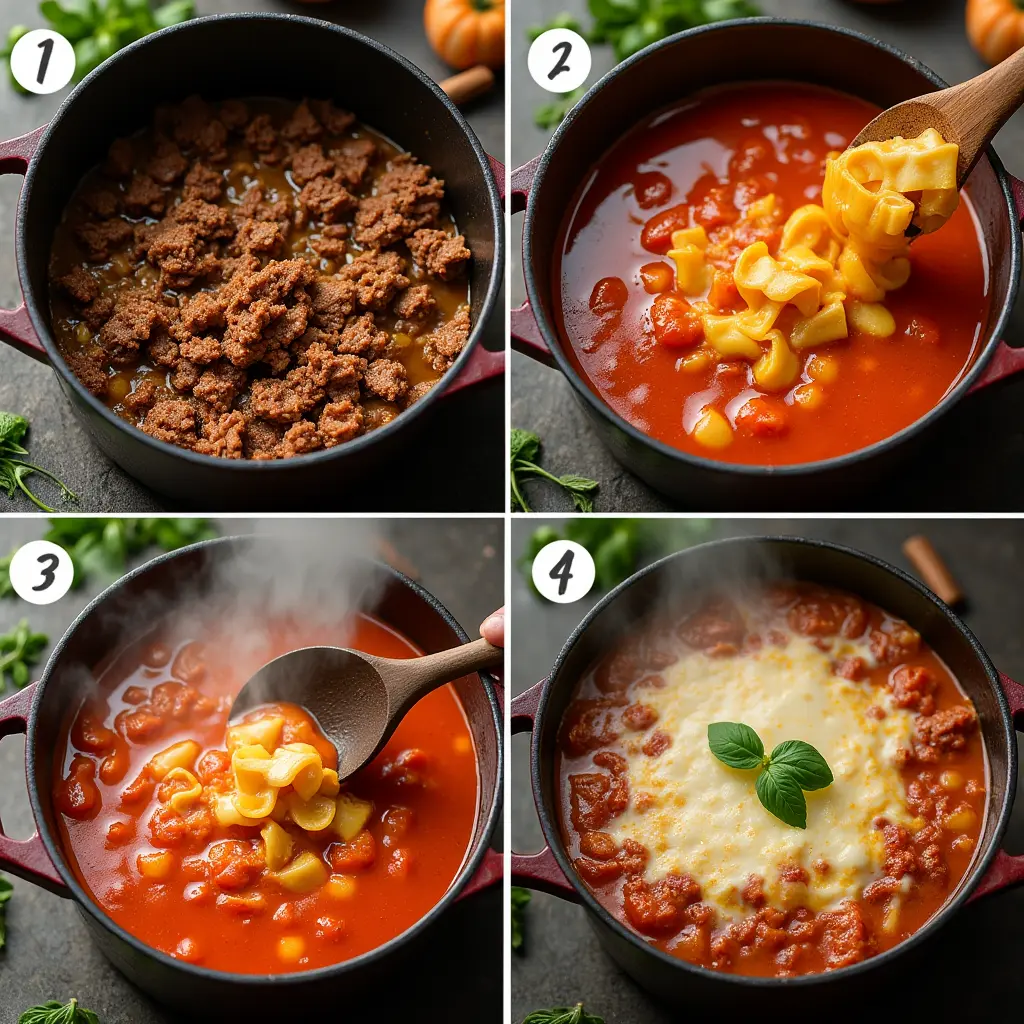
Pro Tips for Perfect Lasagna Soup
Temperature Control
- Maintain steady simmer
- Avoid rapid boiling
- Monitor heat carefully
- Adjust liquid as needed
Texture Management
- Don’t overcook pasta
- Stir occasionally
- Watch liquid consistency
- Add broth as needed
Flavor Enhancement
- Layer seasonings gradually
- Taste and adjust frequently
- Balance acid and salt
- Consider finishing oil
Flavor Variations
Italian-Inspired Twists
Traditional Regional Variations
- Tuscan Style
- Add white beans and kale
- Use more herbs like rosemary and sage
- Include pancetta for depth
- Sicilian Influence
- Add eggplant and capers
- Include more garlic and red pepper
- Use pecorino instead of parmesan
- Northern Italian
- Add mushrooms and truffle oil
- Include more cream
- Use fontina cheese
Modern Interpretations
- Mediterranean Style
- Add artichoke hearts
- Include kalamata olives
- Mix in sun-dried tomatoes
- Finish with lemon zest
- Spicy Variations
- Add calabrian chilies
- Include spicy Italian sausage
- Mix in red pepper flakes
- Top with spicy olive oil
Dietary Modifications
Vegetarian Version
- Replace meat with:
- Mixed mushrooms (portobello, porcini)
- Lentils for protein
- Plant-based ground meat substitute
- Extra vegetables for bulk
Gluten-Free Options
- Pasta alternatives:
- Gluten-free lasagna noodles
- Zucchini ribbons
- Palm heart noodles
- Rice pasta variations
Low-Carb Adaptations
- Noodle substitutes:
- Cabbage ribbons
- Palmini noodles
- Cauliflower pieces
- Keto-friendly pasta alternatives
Advanced Cooking Techniques
Layering Flavors
Building the Base
- Start with aromatic vegetables
- Proper sautéing technique
- Temperature control
- Color development
- Meat browning
- Working in batches
- Proper spacing
- Fond development
Developing Depth
- Deglazing process
- Wine selection
- Timing considerations
- Scraping technique
- Herb incorporation
- Fresh vs. dried timing
- Blooming dried herbs
- Fresh herb finishing
Temperature Management
Heat Control
- Initial high heat for browning
- Medium heat for vegetables
- Low heat for simmering
- Final adjustments
Timing Considerations
- Meat cooking duration
- Vegetable softening
- Pasta cooking time
- Final resting period
Serving Suggestions
Accompaniments
Bread Options
- Garlic Bread Variations
- Classic buttered
- Cheese-stuffed
- Herb-infused
- Whole grain options
- Crusty Bread Choices
- Italian ciabatta
- Sourdough
- Focaccia
- Baguette
Side Salads
- Traditional Italian
- Mixed greens
- Simple vinaigrette
- Shaved parmesan
- Pine nuts
- Modern Interpretations
- Arugula and fennel
- Citrus segments
- Balsamic reduction
- Toasted walnuts
Beverage Pairings
Wine Selections
- Red Options
- Chianti Classico
- Sangiovese
- Primitivo
- Montepulciano
- White Choices
- Pinot Grigio
- Verdicchio
- Soave
- Trebbiano
Non-Alcoholic Options
- Italian sodas
- Sparkling water with citrus
- Herb-infused lemonades
- Coffee for dessert
Storage and Reheating
Short-Term Storage
Refrigeration Guidelines
- Proper cooling methods
- Container selection
- Temperature control
- Maximum storage time
Component Separation
- Noodle storage
- Broth maintenance
- Cheese handling
- Garnish preservation
Long-Term Storage
Freezing Methods
- Soup Base
- Cooling process
- Container selection
- Labeling system
- Thawing instructions
- Component Storage
- Separate freezing
- Packaging techniques
- Temperature requirements
- Quality maintenance
Troubleshooting Guide
Common Issues
Texture Problems
- Too Thick
- Adding liquid
- Temperature adjustment
- Stirring techniques
- Prevention tips
- Too Thin
- Reduction methods
- Thickening options
- Temperature control
- Time management
Flavor Balance
- Too Salty
- Dilution techniques
- Adding acids
- Cream addition
- Prevention methods
- Too Bland
- Seasoning enhancement
- Herb addition
- Cheese incorporation
- Umami boosters
Frequently Asked Questions
Preparation Questions
Q: Can I make this ahead of time?
A: Yes, but store components separately. The base can be made up to 3 days ahead, with noodles and cheese added when reheating.
Q: How do I prevent the noodles from getting mushy?
A: Cook noodles al dente and store separately if not serving immediately. Add to individual portions when reheating.
Q: Can I use different types of meat?
A: Yes, ground turkey, chicken, or plant-based alternatives work well. Adjust seasoning accordingly.
Storage Questions
Q: How long does it keep in the refrigerator?
A: Properly stored, it lasts 3-4 days. Keep noodles separate for best results.
Q: Can I freeze individual portions?
A: Yes, freeze without noodles and cheese for up to 3 months. Thaw overnight in refrigerator.
Serving Questions
Q: What’s the best way to reheat?
A: Gently on stovetop, adding broth if needed. Microwave individual portions carefully.
Q: How do I adjust for a crowd?
A: Recipe easily doubles or triples. Maintain proper ratios and use larger pot.
Conclusion
This comprehensive guide to making lasagna soup demonstrates how traditional Italian comfort food can be transformed into a quick, delicious meal without sacrificing flavor. By following these detailed instructions and tips, you’ll create a dish that rivals traditional lasagna while saving time and effort.
Remember to experiment with variations and make the recipe your own. The versatility of this dish allows for countless adaptations while maintaining its comforting essence. Share your creations with friends and family, and don’t forget to save some for leftovers – it often tastes even better the next day!
Final Tips for Success
- Trust your instincts with seasoning
- Don’t rush the base-building process
- Keep extra broth handy for adjustments
- Taste and adjust throughout cooking
- Have fun with garnishes and toppings
Join our community of home cooks who’ve discovered the joy of this simplified Italian classic. Tag your creations on social media and share your own variations with fellow food enthusiasts. Buon appetito!





